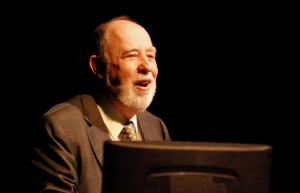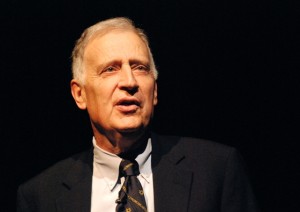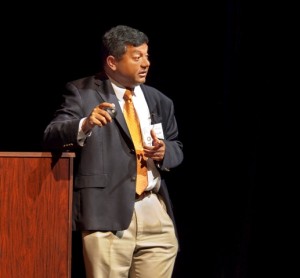At the opening day of the Philomathia Foundation Symposium at Berkeley: Pathways to a Sustainable Energy Future, the audience learned the following three facts: as a result of carbon emissions from human activity, our planet’s climate is changing faster than models have predicted; improved energy efficiency alone is not enough to fix the problem, therefore new breakthroughs in sustainable energy technologies are needed; however, as a nation, we spend more money on potato chips than we do on sustainable energy research and development.
“The provision of sustainable energy is the defining problem of the 21st century, one that presents a challenge of unprecedented scale. Decisions we make now will influence the planet for thousands of years, and dictate our quality of life in both the near and long term,” said Graham Fleming, Vice Chancellor for Research at the University of California (UC) Berkeley and a faculty scientist at Lawrence Berkeley National Laboratory (Berkeley Lab).
Fleming was the organizer of a two day public symposium held on October 1 and 2, 2010 at the Berkeley Repertory Theatre that featured leading authorities on solar and biofuel energy, climate science, urban design and other areas of research critical to sustainable energy technologies. Sponsored by the Philomathia Foundation and hosted by UC Berkeley, the symposium was intended to lay out the best course of action for a clean, green energy future. Nearly a thousand people registered for the event, which included a live Webcast of the proceedings.
Following a video welcome from UC Berkeley Chancellor Robert Birgeneau and opening remarks from Fleming, the symposium kicked off with a presentation by Ralph Cicerone, President of the National Academy of Sciences, titled “Climate Change and Human Usage of Energy.”
Early in his presentation, Cicerone, an expert on atmospheric chemistry, climate change and energy, showed a graph of the monthly average atmospheric carbon dioxide concentrations recorded for the past 50 years at observatories in Hawaii and the South Pole. The climb upwards has been both relentless and steep, rising from approximately 310 parts per million to about 385 parts per million. Another graph showed that global fossil fuel carbon dioxide emissions went from virtually zero in the mid-1800s to approaching 9 billion tons in 2010.
“This increases in carbon dioxide is from human activities,” Cicerone said, “with approximately 85-percent coming from the burning of fossil fuels and the rest from deforestation.”
The evidence for human activity being responsible for the increase in atmospheric carbon dioxide levels is overwhelming, Cicerone said, citing among other factors the rise in carbon dioxide levels that mirrors the usage of fossil fuels, and the geographical patterns and isotopic contents of atmospheric carbon dioxide that match human industry. He also noted that not only do contemporary atmospheric carbon dioxide amounts exceed those of the previous four glacial cycles, but ice-core data show that methane and nitrous oxide amounts are also higher than ever before.
“There is virtually no remaining suggestion that the atmospheric carbon dioxide increase is the result of anything other than fossil fuel usage,” Cicerone said.
Sea-levels are also on the rise, with average tides now some 20 centimeters higher than they were at the end of the 19th century. Furthermore, the oceans are getting both warmer and more acidic, neither of which is beneficial for us.
Cicerone said that whereas the physical principles behind the “greenhouse effect” can explain the global warming that has transpired since the late 1970’s, whereas other explanations, such as the notion that the sun is putting out more energy, fail.
In talking about the scale of what needs to be done, Cicerone said that to stabilize atmospheric carbon levels and keep them out of the danger zone, we must keep carbon dioxide emissions below one gigaton per year. This, he said, will require that energy use in buildings be cut 20-25 percent below business as usual in 2050, or that two billion cars get 60 miles to the gallon rather than 30, or that carbon be captured and stored for 800 1-GWe coal-burning power plants, or 700 1-GWe nuclear plants replacing coal plants, or one million 2-MWe(peak) wind turbines replacing coal power plants, or 2,000 1-GWe(peak) photovoltaic power plants replacing coal power plants.
While these numbers show how daunting the task of reducing carbon emissions will be, Cicerone did offer hope that it can be done, citing the impact of energy-efficiency advocate Art Rosenfeld, a Berkeley Lab and UC Berkeley scientist and California Energy Commissioner. As a result of Rosenfeld’s recommendations, electricity use per person in this state has remained relatively flat for the past 39 years, while it has steadily increased for the rest of the United States.
“Improved energy efficiency would decrease our dependency on foreign oil, improve our national security, decrease our trade deficit, decrease local air pollution, increase our national competitiveness, encourage development of new products for global markets, and decrease household energy costs,” Cicerone said. “At the same it would also slow the increases of atmospheric carbon dioxide and methane.”
Environment
Presentations at the Philomathia Foundation energy symposium were organized into four key areas: environment, energy supply, energy demand and energy policy. Keynoting the session on environment was Chris Field, founding director of the Carnegie Institution’s Department of Global Ecology, and professor of biology and environment at Stanford University. He is also co-chair of the International Panel on Climate Change’s Working Group Two.
In his talk, titled “The Velocity of Climate Change,” Field cited an article in 1896 in the Philosophical Magazine and Journal of Science by the Swedish scientist Svante Arrhenius, in which he foretold of the greenhouse effect with startling accuracy. Field also noted that in 1965, President Lyndon Johnson acknowledged the threat of global warming from the burning of fossil fuels, as did a detailed study in 1979 from the National Academy of Sciences. In spite of these warnings that date back so many decades, the response to date has been inadequate.
“With regards to global climate change, we are playing with loaded dice and we are dumping nails on the road of life,” Field said.
Field maintained that we have the technology and industrial know-how to solve the global climate problem, but there has been considerable foot-dragging when it comes to implementing these technologies on the time scales that are so critical to the problems of global climate change.
“The rate of climate change sets a pace for spatial shifts in species and ecosystems and for development of adaptation strategies by individuals, enterprises and nations,” he said. “Critical interactions with the underlying rate of climate change come from the rate at which affected systems perceive that climate is changing and convert that perception into action.”
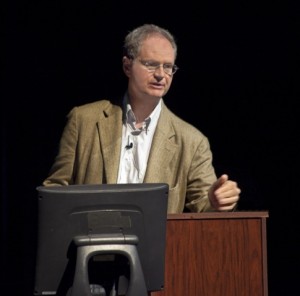
Berkeley Lab director Paul Alivisatos highlighted Carbon Cycle 2.0, an initiative aimed at correcting the imbalance in the carbon cycle from human activity. (photo by Roy Kaltschmidt)
Field used the Hoover Dam as an example of time scale for major energy infrastructures. Construction on the dam was started in 1931 and completed in 1936. As we all know, 75 years later, the dam is still in use with no replacement on the horizon.
“Cost alone means that these infrastructures are going to be around for a long time, but when you factor in the time required to retire an existing infrastructure and to develop, deploy, and scale new replacement technologies, the time scale becomes much larger,” he said.
Climate changes persist many centuries and the risks such changes pose can never be predicted with 100-percent certainty, Field said. Meanwhile, developing solutions takes time and artificial controversy costs time and opportunity and allows risks and damages to accumulate. These factors all contribute to the foot-dragging which not only increases the risks but postpones the co-benefits of new technologies and jeopardizes opportunities to seize technological leadership.
Field closed with a tribute to climate change scientist and public advocate Stephen Schneider who passed away earlier this year, then posted a cartoon in which a skeptic asks: “What if (global warming) is a big hoax and we create a better world for nothing?”
Other presenters at the Environment session of the symposium were:
- Berend Smit, UC Berkeley professor of chemistry and chemical engineering, who spoke on “Carbon Capture and Storage: Discovering the Science of Carbon Dioxide”
- William Collins, head of the Climate Science Department, Earth Sciences Division, Berkeley Lab, who spoke on “Advancing Climate Science for a Sustainable Energy Future”
- Charles Marshall, Director, UC Museum of Paleontology and UC Berkeley professor of integrative Biology, who spoke on “Gauging Ecosystem Response” and
- Inez Fung, Director, UC Berkeley Institute of the Environment, who spoke on “Verifying Climate Treaties.”
Energy Supply
The energy supply session of the symposium was keynoted by Arun Majumdar, Director of the Advanced Research Projects Agency – Energy (ARPA-E), the country’s only agency devoted to transformational energy research and development. Before taking this post in 2009, Majumdar served as Berkeley Lab’s Associate Laboratory Director for Energy and Environment, and was a UC Berkeley professor of mechanical engineering and materials Science. In his talk, titled “Innovations in Energy Technologies – The Role of ARPA-E,” Majumdar referred to today’s energy crisis as our “Sputnik moment” in history.
“We have witnessed multiple wake-up calls with regard to the need for innovation in energy technologies,” Majumdar said. “Yet we currently import 60-percent of our oil and we need to make that zero.”
ARPA-E was created, he said, to address our nation’s need to reduce energy imports, reduce energy-related emissions, improve energy efficiency of all economic sectors, and ensure technological leadership for the United States.
“This mission is at the core of our national, economic and environmental security,” Majumdar said.
Majumdar lamented that other nations are currently being far more aggressive and far-sighted in their commitment to sustainable energy research and development than the United States. For example, he said there is only one U.S. firm ranked in the top ten global manufacturers of wind turbines and advanced batteries, and two in the top ten for photovoltaics. The other firms are from China, Denmark, France, Germany, India, Spain, Taiwan and the United Kingdom. He also noted that a company in Japan now produces more than 75-percent of the world’s nickel-metal hydride batteries used in vehicles. In addition to spending more on potato chips than on sustainable energy R&D, we also spend more on dog food R&D than we do on electrical power R&D.
In its first round of R&D funding, ARPA-E has moved forward with unprecedented speed, Majumdar said. Between April and June 2009, 3,700 research proposals were received. Within three months, the review process was completed and in October of this year, ARPA-E expects to announce the selection of 37 projects to be funded an average of $4 million for two to three years.
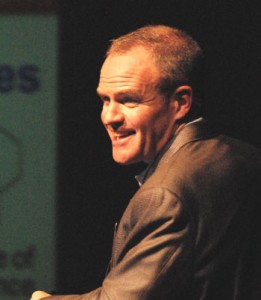
Jay Keasling of the Joint BioEnergy Institute, described how JBEI researchers are using synthetic biology and other cutting edge technologies to fast-track the development of advanced and sustainable biofuels. (Photo by Peg Skorpinski)
One example of these selected projects was a grant to the biotechnology firm Agrivida for development of fuel plants that produce all the enzymes necessary for breaking down its lignocellulose from within, which Majumdar described as “Putting the cow inside the plant!” Other examples included grants for a high-efficiency Mixer-Ejector-Wind Turbine (MEWT) to the FloDesign Wind Turbine Corporation, and for a grid-level electric storage system to MIT.
“At ARPA-E we are looking for new technologies, devices and prototype systems that do not exist in today’s energy market, are too risky for private sector investment, and if successful could make today’s technologies obsolete, could have large commercial impact, and could produce new learning curves and new markets,” Majumdar said.
Other presenters at the Energy Supply session of the symposium were:
- Chris Somerville, Director of the Energy Biosciences Institute (EBI) and UC Berkeley’s Philomathia Professor of Alternative Energy, who spoke on “Bioenergy”
- Alex Bell, UC Berkeley professor of chemical engineering and faculty researcher at Berkeley Lab, who spoke on “Chemical Strategies for Converting Biomass to Fuels”
- Paul Alivisatos, Director of Berkeley Lab and UC Berkeley’s Larry and Diane Bock Professor of Nanotechnology, who spoke on “The Carbon Cycle 2.0 Initiative at the Berkeley Lab” and
- Jay Keasling, CEO, Joint BioEnergy Institute (JBEI), faculty researcher at Berkeley Lab and UC Berkeley professor of chemical engineering and bioengineering, who spoke on “The Joint BioEnergy Institute: Start-up for Advanced Biofuels.”
Videos of all the presentations will soon be available on the Berkeley Research Website. Visit the url at http://vcresearch.berkeley.edu/
